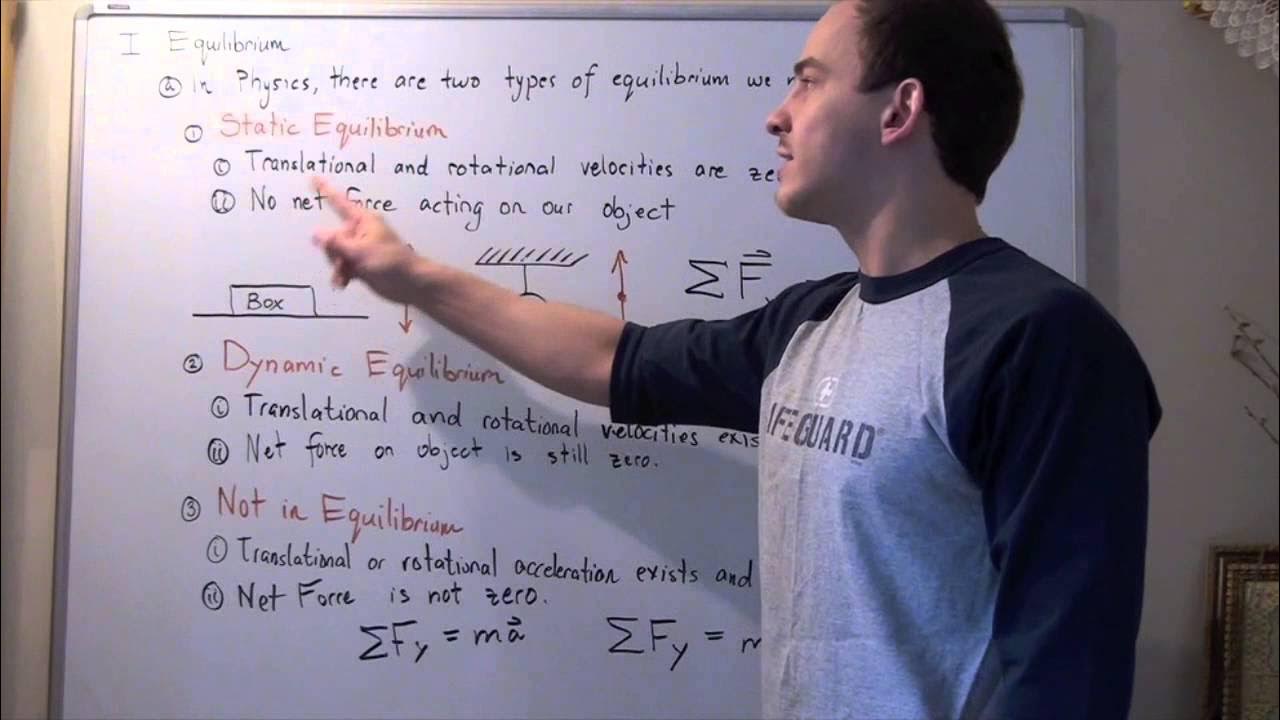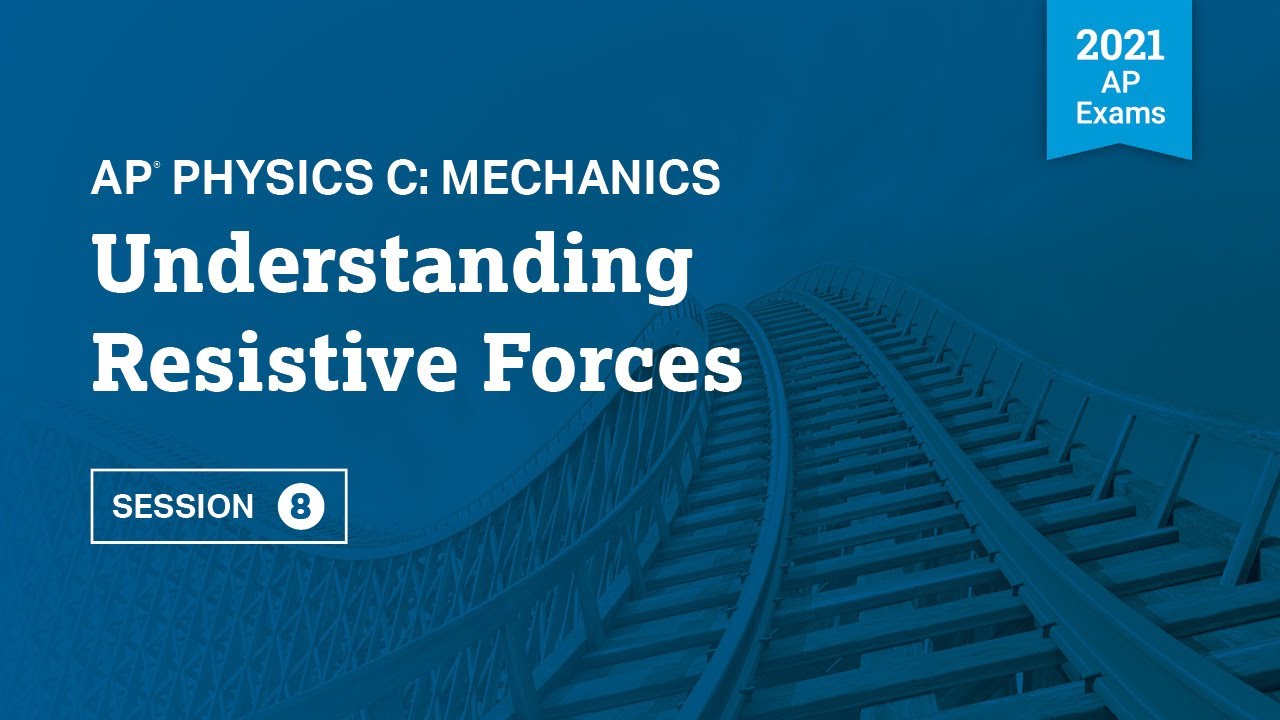AP Physics 1 - Air Resistance
TLDRIn this informative video, Dan Fullerton discusses air resistance and its impact on moving objects. He explains how air resistance, a form of drag, varies with velocity and can be modeled using linear or quadratic relationships. The concept of terminal velocity is introduced, where an object in free fall reaches a constant velocity due to the balance between gravitational force and air resistance. The video provides a clear explanation of the physics involved, using Newton's second law to derive equations for terminal velocity and illustrating the concepts with graphs of acceleration, velocity, and displacement over time.
Takeaways
- 📈 Air resistance is a type of drag or fluid resistance, which is the force of friction between a moving object and the air around it.
- 🚀 The force of air resistance is dependent on the speed of the object, increasing as the object moves faster.
- 📊 Terminal velocity (V_T) is the constant velocity an object falls at when the drag force equals the gravitational force acting on it, resulting in no acceleration.
- 📐 Utilizing Freebody diagrams helps identify the forces exerted on an object and is essential for solving Newton's second law equations related to motion.
- 🧮 Newton's second law of motion (F = ma) can be applied to predict the motion of an object under multiple forces, including air resistance.
- 📉 The drag force can be modeled as proportional to the linear velocity (BV) or the square of the velocity (constant times velocity squared), though it can sometimes be a combination of both.
- 🚶♂️ At time T=0, when the skydiver jumps out of the plane, the vertical velocity is zero, and so is the drag force, resulting in an initial acceleration equal to gravity (G).
- 📈 As time progresses (T → ∞), the skydiver's velocity approaches terminal velocity (V_T), and the acceleration in the Y direction approaches zero.
- 📊 The acceleration-time graph starts at G (acceleration due to gravity) and declines to zero as the skydiver reaches terminal velocity.
- 📈 The velocity-time graph for terminal velocity starts at zero and increases until it reaches the asymptote, V_T (mg/B).
- 📊 The displacement-time graph begins at zero and increases linearly once the object reaches a constant velocity at terminal velocity.
- 💡 Understanding these concepts is crucial for predicting the behavior of objects under the influence of air resistance and can be further explored on A+ Physics.com.
Q & A
What is air resistance?
-Air resistance is a type of drag or fluid resistance that represents the force of friction between a moving object and the air around it. It depends on the speed of the object, with faster speeds resulting in greater air resistance.
How does air resistance affect a moving object?
-Air resistance affects a moving object by creating a force of friction that opposes its motion. The faster the object moves, the greater the air resistance it experiences, which can slow it down or even bring it to a stop, depending on the balance with other forces acting on it.
What is the relationship between air resistance and velocity?
-Air resistance is generally proportional to the velocity of the object. It can be linearly proportional or proportional to the square of the velocity, depending on the situation and the object's shape, size, and other factors.
What is terminal velocity?
-Terminal velocity is the constant vertical velocity that an object reaches when the drag force due to air resistance balances the gravitational force acting on it. At this point, the object no longer accelerates and moves at a constant speed in a straight line.
How does an object reach terminal velocity?
-An object reaches terminal velocity by accelerating downwards under the influence of gravity until the air resistance it experiences equals the gravitational force acting on it. At this balance point, the object stops accelerating and moves at a constant velocity.
What is the equation for calculating terminal velocity?
-The equation for terminal velocity, assuming the drag force is proportional to the velocity, is VT = mg/B, where VT is the terminal velocity, m is the mass of the object, g is the acceleration due to gravity, and B is the constant of proportionality for the drag force.
How does the acceleration of a skydiver change over time as they fall?
-Initially, when a skydiver jumps out of a plane, their acceleration is equal to the acceleration due to gravity (g). Over time, as their velocity increases and approaches terminal velocity, the acceleration decreases until it reaches zero when the skydiver is in dynamic equilibrium at terminal velocity.
What does the acceleration-time graph look like for a skydiver falling towards terminal velocity?
-The acceleration-time graph starts at g (acceleration due to gravity) and gradually declines to zero as the skydiver approaches terminal velocity. The graph has a shape that decreases towards an asymptote at zero acceleration.
What does the velocity-time graph for reaching terminal velocity show?
-The velocity-time graph for reaching terminal velocity starts at zero velocity and increases until it reaches the terminal velocity (VT), which is an asymptote. The graph shows an initial rapid increase in velocity that levels off as it approaches the terminal velocity.
How is the position-time graph for a skydiver falling towards terminal velocity represented?
-The position-time graph begins at zero and increases linearly as time passes. Initially, the rate of increase is slow, but as the skydiver approaches terminal velocity, the rate of increase becomes constant, representing a linear regime with a constant velocity.
What happens to the drag force as an object's velocity approaches terminal velocity?
-As an object's velocity approaches terminal velocity, the drag force increases until it balances the gravitational force acting on the object. At terminal velocity, the drag force is at its maximum and equals the gravitational force, resulting in no further acceleration.
Outlines
📘 Introduction to Air Resistance and Newton's Second Law
This paragraph introduces the topic of air resistance, a type of fluid resistance that occurs due to the friction between a moving object and the air around it. The main objective is to use Freebody diagrams to identify forces on an object and solve Newton's second law equations to predict the motion of an object under various forces, including air resistance. The concept of terminal velocity is introduced, explaining it as the constant velocity an object reaches when the drag force equals the gravitational force, resulting in no further acceleration. An example of a skydiver is used to illustrate the application of Newton's second law in calculating terminal velocity, highlighting the relationship between drag force, mass, gravitational force, and acceleration.
📊 Graphing Terminal Velocity and Understanding Acceleration
This paragraph delves into the graphical representation of terminal velocity and the acceleration over time. It explains how the acceleration begins at the acceleration due to gravity (G) when the skydiver jumps out of the airplane and gradually decreases to zero as the skydiver approaches terminal velocity. The paragraph also discusses the shape of the acceleration-time graph and the velocity-time graph, where the velocity starts at zero and increases to reach the terminal velocity (VT). Additionally, the displacement-time graph is described, showing how displacement starts at zero and increases at a constant rate once the object reaches terminal velocity. The paragraph concludes by summarizing the key points and encouraging further exploration of the topic for a deeper understanding.
Mindmap
Keywords
💡Air Resistance
💡Freebody Diagrams
💡Newton's Second Law
💡Terminal Velocity
💡Drag Force
💡Velocity
💡Acceleration
💡Dynamic Equilibrium
💡Gravitational Force
💡Position-Time Graph
💡Acceleration-Time Graph
Highlights
Air resistance is a type of drag or fluid resistance, which is a force of friction between a moving object and the air around it.
The force of air resistance depends on how fast an object is moving; the faster the object, the more air resistance it encounters.
Air resistance can be proportional to the linear velocity or the square of the velocity, making it a complex force to model.
Terminal velocity is the maximum vertical velocity an object reaches when the drag force equals the gravitational force acting on it.
At terminal velocity, an object is in dynamic equilibrium, moving at a constant velocity with zero acceleration and net force.
The equation for terminal velocity can be derived using Newton's second law and is given by VT = mg/B, where m is the mass, g is the acceleration due to gravity, and B is the constant related to air resistance.
When a skydiver jumps from a plane, their acceleration begins at the acceleration due to gravity and decreases over time as they approach terminal velocity.
The acceleration-time graph for a skydiver shows an initial acceleration equal to gravity that decreases to zero as they reach terminal velocity.
The velocity of a skydiver starts at zero and increases until it reaches the terminal velocity, which can be represented on a velocity-time graph.
The position or displacement of a skydiver starts at zero and increases linearly once the velocity reaches a constant rate at terminal velocity.
Freebody diagrams are essential tools for identifying the forces exerted on an object and solving Newton's second law equations.
Pseudo Freebody diagrams can help predict the motion of an object due to multiple forces by applying Newton's second law of motion.
Understanding air resistance and terminal velocity is crucial for applications in aerodynamics and aerospace engineering.
The concept of terminal velocity has practical applications in activities like skydiving and can help in designing safety protocols and equipment.
The relationship between air resistance and velocity can be tested in everyday scenarios, such as sticking your hand out of a car window at different speeds.
The mathematical modeling of air resistance and terminal velocity can lead to a better understanding of the physical forces at play in various real-world situations.
Transcripts
Browse More Related Video
5.0 / 5 (0 votes)
Thanks for rating:





